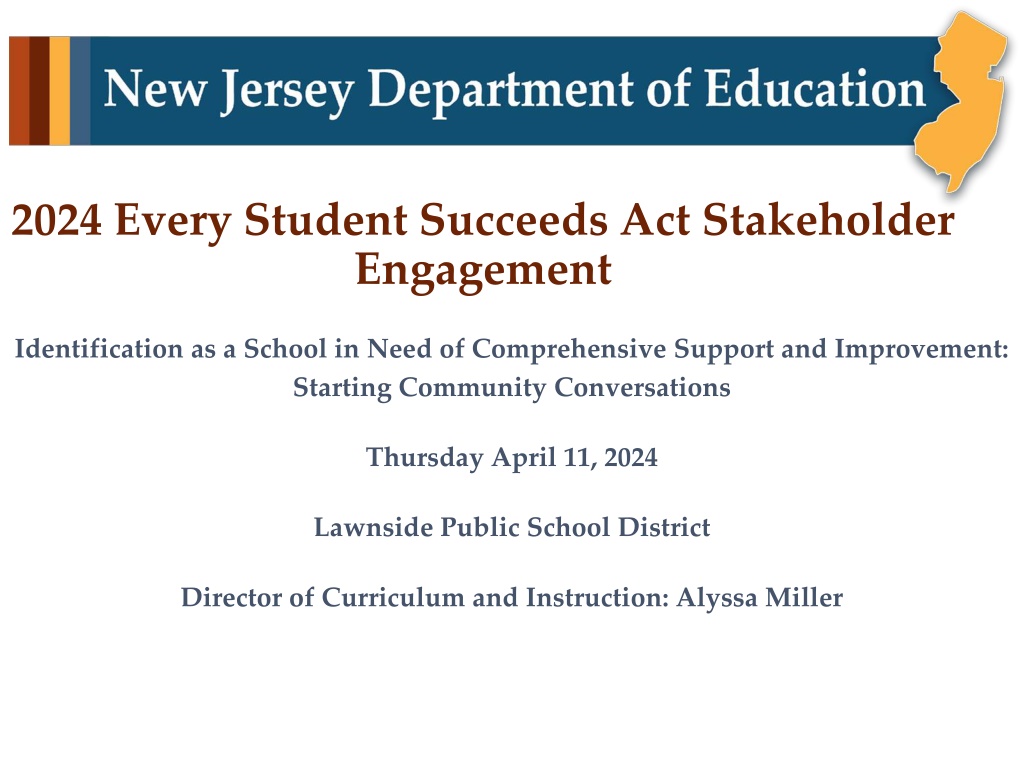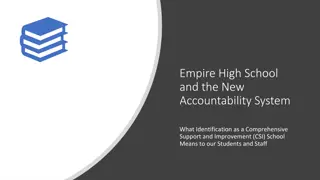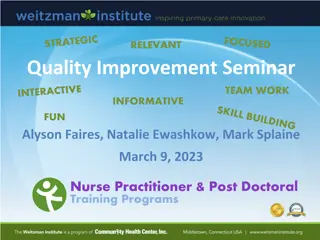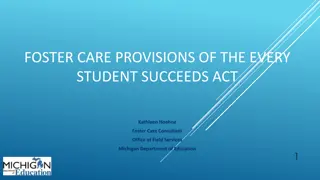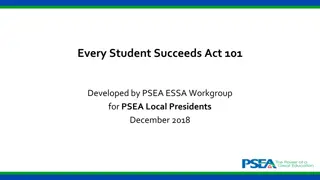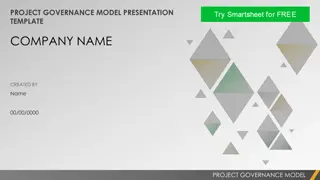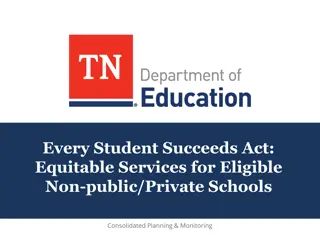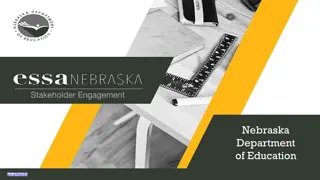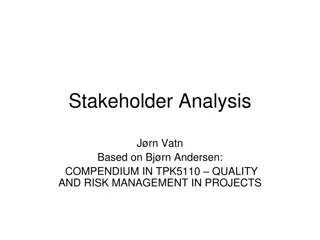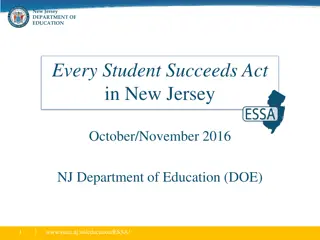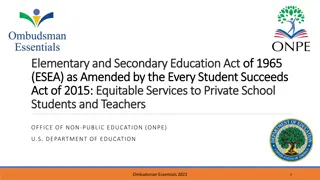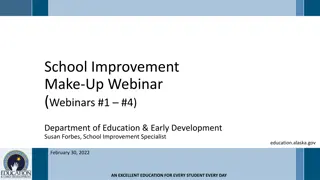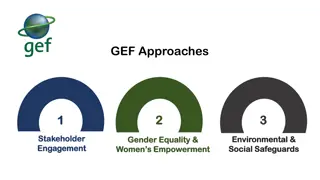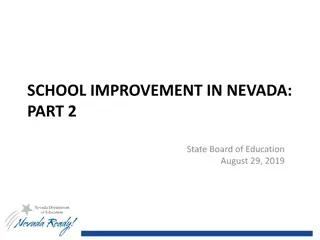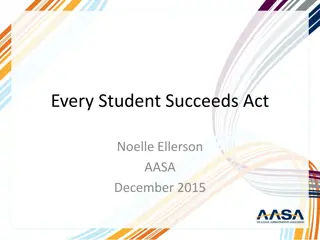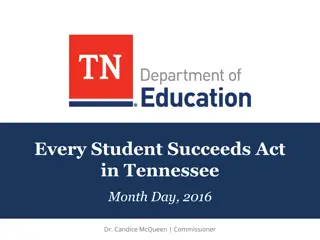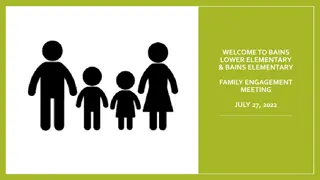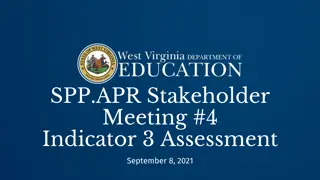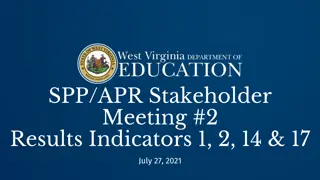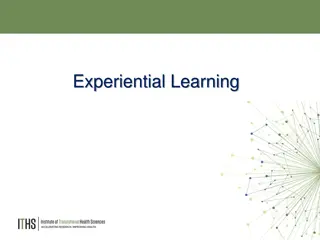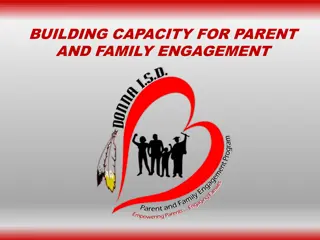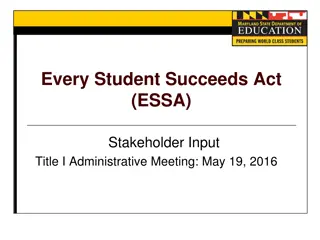Understanding Every Student Succeeds Act - Stakeholder Engagement and School Improvement
This presentation delves into the Every Student Succeeds Act (ESSA) and how it impacts schools identified for comprehensive support and improvement in New Jersey. It covers the criteria for school identification, accountability systems, and the role of stakeholders in enhancing educational experiences for all students.
Uploaded on May 10, 2024 | 6 Views
Download Presentation

Please find below an Image/Link to download the presentation.
The content on the website is provided AS IS for your information and personal use only. It may not be sold, licensed, or shared on other websites without obtaining consent from the author. Download presentation by click this link. If you encounter any issues during the download, it is possible that the publisher has removed the file from their server.
E N D
Presentation Transcript
2024 Every Student Succeeds Act Stakeholder Engagement Identification as a School in Need of Comprehensive Support and Improvement: Starting Community Conversations Thursday April 11, 2024 Lawnside Public School District Director of Curriculum and Instruction: Alyssa Miller
Presentation Overview This presentation will cover the following topics: Background information about the Every Student Succeeds Action (ESSA) How schools are identified for enter identification status and improvement Next steps for our school and collaboration
ESSA On August 9, 2017, the U.S. Department of Education approved New Jersey's ESSA State Plan, which was developed in collaboration with stakeholders from across New Jersey. The plan emphasizes New Jersey s collective expectation that all students have equal access to high-quality educational experiences so they may all reach their greatest potential. To fulfill this promise to our students, the New Jersey Department of Education (NJDOE) is obligated by federal law, and New Jersey s ESSA State Plan, to identify schools in need of comprehensive and targeted support and improvement.
ESSA School Accountability: Overview School accountability in ESSA is just one of the New Jersey accountability systems meant to improve student access to high-quality education programs. Its role is to identify our schools most in need of support and improvement. School and District Reporting District Accountab ility (QSAC) School Accountabi lity (ESSA) School Accountabil ity (ESSA)
How Was Our School Identified? New Jersey s ESSA school accountability system provides a formula to determine a performance score, which is based on various measures of progress (accountability indicators). Our school has been identified based on its relative low performance using these measures.
What is a CSI School? A school is identified for comprehensive support and improvement (CSI) if any of the following three criteria apply: Summative score is at or below the bottom 5th percentile of Title I schools Four-year graduation rate at or below 67% Title I school that has been identified as in need of targeted support and improvement for three or more consecutive years Schools are typically identified for comprehensive support and improvement every three years.
How Were We Identified We were identified because our summative score is at or below the bottom 5th percentile of Title I schools State Cut of Score:11.64 Our Score: 6.91 7
What Happens Next? Schools identified for support and improvement work in partnership with their education community of parents, families, educators, and community members throughout the year to: Assess needs related to the areas of weakness Identify strategies and resources that can impact improvement Establish an Annual School Plan Team with varied stakeholders Create an Annual School Plan that will outline specific steps Outline a timeline for completion of those steps Understand the steps needed to be removed from status The District will be given additional funds to aid in academic endeavors
How Can I Get Involved? Schools and districts are required to engage with parents, families, educators, and community members throughout the year to assess needs related to the areas of weakness, identify strategies and resources that can impact improvement, create an improvement plan and timeline for completion. See NJDOE s Stakeholder Engagement Guide for detailed descriptions of these requirements. The National Partnership for Student Success
How Can We Learn More? Detailed school information will be publicly available on the NJDOE website in School Performance Reports: NJ School Performance Report. School Performance Reports: Provide families, educators and the public a picture of overall school performance. Include valuable information across many elements, including schoolwide academic achievement and progress, demographics, school climate, chronic absenteeism, and college and career readiness. Can be used to start local conversations by asking questions such as: How is our school doing relative to other schools? Are all of our students making progress from last year?
Current Benchmark Data End of Cycle 2 iReady Diagnostic Winter Benchmark Data 60 % of students met their Annual Typical Growth or Higher(The goal was 70%) 51 % of students met their Annual Typical Growth or Higher(The goal was 70%)
Additional Resources State of New Jersey Parent Link New Jersey Department of Education NJDOE s ESSA Accountability Website Parent and Family Resources https://videos.curriculumassociates.com/watch/o9Dcjq6 xipPJFa5iGWcib8? 12
For More Information Visit our district website for updates www.lawnside.k12.nj.us Email questions: Alyssa Miller amiller@lawnside.k12.nj.us 856-546-4850 ext:2247
